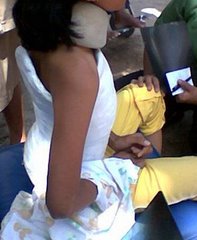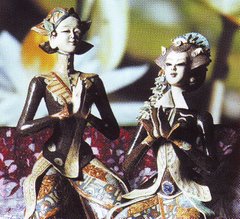
Knee pain bilateral with history stroke, and slight paretic at the left side.

19 y o , obesity girl
Please, cut your weight

65 y.o lady, bony enlargment, right side bigger than the laeft.
-- the daily life of a PMR specialist, facing pain in daily practice --



I swear by Apollo Physician and Asclepius and Hygieia and Panaceia and all the gods and goddesses, making them my witnesses, that I will fulfill according to my ability and judgment this oath and this covenant:
To hold him who has taught me this art as equal to my parents and to live my life in partnership with him, and if he is in need of money to give him a share of mine, and to regard his offspring as equal to my brothers in male lineage and to teach them this art – if they desire to learn it – without fee and covenant; to give a share of precepts and oral instruction and all the other learning to my sons and to the sons of him who has instructed me and to pupils who have signed the covenant and have taken an oath according to the medical law, but to no one else.
I will apply dietetic measures for the benefit of the sick according to my ability and judgment; I will keep them from harm and injustice.
I will neither give a deadly drug to anybody if asked for it, nor will I make suggeastion to this effect. Similarly I will not give to a woman an abortive remedy. In purity and holiness I will guard my life and my art.
I will not use the knife, not even on sufferers from stone, but will withdraw in favor of such men as are engaged in this work.
Whatever houses I may visit, I will come for the benefit of the sick, remaining free of all intentional injustice, of all mischief and in particular of sexual relations with both female and male persons, be they free of slaves.
What I may see or hear in the course of the treatment or outside of the treatment in regard to the life of men, which on no account one must spread abroad, I will keep to myself holding such things shameful to be spoken about.
If I fulfill this oath and do not violate it, may it be granted to me to enjoy life and art, being honored with fame among all men for all time to come; if I transgress it and swear falsely, may the opposite of all this be my lot.










Mr Djoko, one of my patient, came to me 2 weeks ago. He suddenly loss his hearing at the left side. Laser given by ILIB and ear probe . After the first treatment, he felt “better”, no “full” sensation again on his lefl ear. Everyday laser for four times, and ones a week after the 4th , :
The audiogram after treatment : found normal
He already got stroke few years ago, his hearing loss could cause by ischemic. Lee and Baloh found that ten percent of patients with vertebrobasilar stroke had unilateral hearing loss, almost always with vertigo. Treatment with steroids has class I evidence for being a beneficial treatment--even if the cause turns out to be vascular. Usually tapering oral steroids are given, sometimes with pentoxifylline, and occassionally acyclovir or valacyclovir.
For Ms Djoko, the Laser combine with neurotopic agent
From jurnal:
The low level laser therapy of inner ear dysfunction has been made use of in Germany since the end of the eighties (for example by Dr. Uwe Witt, Hamburg and Dr. Lutz Wilden in Bad Fuessing) and is also to be found in quite a few other countries (Italy, France, Scandinavia, Switzerland, Hungary, Japan, Russia etc.). .
As the observation of healing processes has shown in the course of the years, even serious impairments such as the most excruciating cases of tinnitus, hearing loss, vertigo and Meniere's Disease can be considerably alleviated and even healed with the aid of modern Low Level Laser Therapy (LLLT).
How does LLLT work?
For a detailed discussion, see Dr. Lutz Wilden' article: Import of Radiation Phenomena of Electrons and Therapeutic Low-Level Laser in Regard to the Mitochondrial Energy Transfer, Journal of Clinical Laser Medicine & Surgery, Volume 16, Number 3, 1998, Mary Ann Liebert, Inc., Pp.159-165
Each cell contains a number of power plants, called mitochondria. The function of these power plants is to produce ATP, the form of energy which can be used by the cell to function properly.
The inner mitochondrial membrane is a large collector surface folded onto a small total volume. All nutritive molecules (fats, proteins and glucose) are oxidized within the cell to the last molecular nutritive component, that is, pyruvate. The pyruvate is then imported into the cellular power plant, where it disintegrates into carbon dioxide and water in the immediate proximity of the collector surface of the mitochondrion. The molecular bond energy thus released, which corresponds with visible, ultraviolet and infrared light as far as its wavelength and frequency is concerned, is utilized by the mitochondrion to produce the cellular fuel ATP.
The collector surface of our cellular power plant is enlarged by the mushroom-shaped protrusions of the inner mitochondrial membrane. The molecular bond energy of the pyruvate is released in the form of light energy. The antennae pigments are capable of absorbing this light energy and transmit it to our cellular power plant, which can now produce the cellular fuel ATP. The natural solar radiation also stimulates the antennae pigments of the mitochondrion to produce ATP.
Low level laser light is compressed light from the red and infrared spectrum of the electromagnetic radiation. It reaches the cellular power plants of low-lying cells as well and is absorbed by their collector surfaces as an additional source of energy. The cellular power plants can thus produce more ATP. The cellular energy is the fuel the inner ear cells strives after and needs. A sufficiently high supply of cellular energy enables our inner ear cell to work under optimum conditions and is the essential prerequisite to ensure a successful self-healing process.
Low level laser light increases the energy output in our cellular power plant.

The lumbar plexus is a nervous plexus in the lumbar region of the body. It is formed by the loops of communication between the anterior divisions of the first three and the greater part of the fourth lumbar nerves; the first lumbar often receives a branch from the last thoracic nerve.
It is situated in the posterior part of the Psoas major, in front of the transverse processes of the lumbar vertebræ.
The lumbar plexus differs from the brachial plexus in not forming an intricate interlacement, but the several nerves of distribution arise from one or more of the spinal nerves, in the following manner: the first lumbar nerve, frequently supplemented by a twig from the last thoracic, splits into an upper and lower branch; the upper and larger branch divides into the iliohypogastric and ilioinguinal nerves; the lower and smaller branch unites with a branch of the second lumbar to form the genitofemoral nerve.
The remainder of the second lumbar nerve, and the third and fourth lumbar nerves, divide into ventral and dorsal divisions.
The ventral division of the second lumbar nerve unites with the ventral divisions of the third and fourth lumbar nerves to form the obturator nerve.
The dorsal divisions of the second and third nerves divide
| Division | Name | Source | Target |
| Main | Iliohypogastric nerve | 1 L. | Skin over the lateral gluteal region and above the pubis [1] |
| Main | Ilioinguinal nerve | 1 L. | Skin over the root of the penis and upper part of the scrotum (male), skin covering the mons pubis and labium majus (female) |
| Main | Genitofemoral nerve | 1, 2 L. | Genital Branch: Cremaster muscle, skin of scrotum/labia majora Femoral Branch: Skin on anterior thigh |
| Dorsal | Lateral femoral cutaneous | 2, 3 L. | Skin on the lateral part of the thigh |
| Ventral | Obturator nerve (and Accessory obturator nerve, when present) | 2, 3, 4 L. | Medial compartment of thigh |
| Dorsal | Femoral nerve | 2, 3, 4 L. | Anterior compartment of thigh |
| Ventral | Lumbosacral trunk | 4, 5L., 1, 2, 3, 4 S. | Sacral plexus |
into two branches, a smaller branch from each uniting to form the lateral femoral cutaneous nerve, and a larger branch from each joining with the dorsal division of the fourth nerve to form the femoral nerve.
The accessory obturator, when it exists, is formed by the union of two small branches given off from the third and fourth nerves.



Plantar fasciitis causes stabbing or burning pain that's usually worse in the morning because the fascia tightens (contracts) overnight. Once your foot limbers up, the pain of plantar fasciitis normally decreases, but it may return after long periods of standing or after getting up from a seated position.
![]()
Plantar fasciitis usually develops gradually, but it can come on suddenly and be severe. And although it can affect both feet, it more often occurs in only one foot at a time. Watch for:
Under normal circumstances, plantar fascia acts like a shock-absorbing bowstring, supporting the arch in the foot. But, if tension on that bowstring becomes too great, it can create small tears in the fascia. Repetitive stretching and tearing can cause the fascia to become irritated or inflamed. The causes of plantar fasciitis can be:
Your risk of developing plantar fasciitis increases if you are:
Ignoring plantar fasciitis may result in a chronic condition that hinders your regular activities. You may also develop foot, knee, hip or back problems because of the way plantar fasciitis changes your walking motion.
If self-care techniques don't help, your doctor might suggest other treatments to heal your heel.
Conservative treatment
For most people, the condition improves within a year of beginning conservative treatment. Nonsurgical treatments that may promote healing include:
Medications and procedures
If conservative treatment doesn't provide relief, you might consider:
You can take some simple steps now to prevent painful steps later:
![]()
By following these self-care tips, you may be able to eliminate heel pain without further treatment:


Mr A , 51 years old, executive .
Had his tendon repaired 3 months ago due to rupture of Achilles tendon, Mr Agus’ right foot was swollen. His right knee had “contraction” , because he always bend his knee, spam quadriceps. The laser (ILIB and scanner) was given for the relief of swelling and spasm, The major regiment : begin partial weight bearing for right foot, standing balance, walk “properly” with bilateral crutches. The 2nd day : reduced swelling, the 5th day : better standing balance , minimized spasm and he could manage his right knee. He went back to Badak - Bontang –






Again, thank you for visiting my blog.
It’s all about what I have done in my own practice & share them with you. I’m going to update every week.
